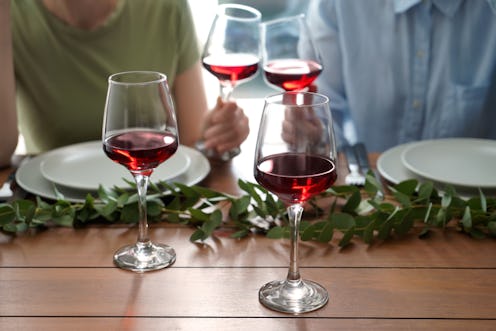Life
Yes, People Do Tend To Drink More When It’s Colder Out, A New Study Shows

Each year, the fall and winter months usher in welcome changes to people’s routines: the arrival of pumpkin-flavored everything, steaming mugs of hot drinks, and holiday parties galore. But as the days get darker and colder, they can also encourage some potentially not-so-great habits. If you find yourself reaching for a glass of wine more often when temperatures dip, you’re not alone. New research from the University of Pittsburgh found that where you live might shape just how much you drink. The study, which investigated the link between weather and alcohol intake, found that people living in colder areas with less sunlight tended to drink more alcohol than their warm-weather peers.
The research, published online in the journal Hepatology, found that as temperatures sink and hours of sunlight diminish, alcohol consumption tends to rise. Colder climates were also linked to more episodes of binge drinking and higher prevalence of alcoholic liver disease. In the U.S., more than a quarter of people aged 18 or older reported engaging in binge drinking in the past month in 2015, according to the National Institute on Alcohol Abuse and Alcoholism. Annually, roughly 88,000 Americans die from alcohol-related causes, marking alcohol as the third leading preventable cause of death in the United States (the first is tobacco, and the second is poor diet and physical inactivity).
"It's something that everyone has assumed for decades, but no one has scientifically demonstrated it." said study author Dr. Ramon Bataller in a statement. "This is the first study that systematically demonstrates that worldwide and in America, in colder areas and areas with less sun, you have more drinking and more alcoholic cirrhosis."
The study used data sets that covered 193 countries, 50 U.S. states, and 3,144 U.S. counties, sourced from the World Health Organization and the World Meteorological Organization, among other groups. A significant negative correlation was identified between environmental variables, like average temperature and sunlight hours, and alcohol consumption. Alcohol consumption was measured through factors including total alcohol intake per capita and the percent of the population that indulges in drinking alcohol. Climate was also associated with higher levels of alcoholic liver disease in populations, which remained true across countries in the world, as well as when comparing counties within the U.S.
Of course, environment is not the only factor at play here, as variables like religion and socioeconomic status can also play a role in how much individuals do or do not drink. The findings are correlations, not causations, and it’s of note that the research was partially funded by grants from the National Institute on Alcohol Abuse and Alcoholism.
If you do find yourself drinking more alcohol than you typically would over the winter, you have options. You can speak to a mental health counselor about strategies to avoid alcohol over the winter; this may be especially helpful if you have a personal or family history of substance use. You can also try out a new exercise routine with friends to break up the mood-lowering effects of winter or seasonal affective disorder. For the times where you are stuck indoors and aren’t feeling great, take advantage of what sunlight there is by keeping your blinds open. Surrounding yourself with bright environments can be a useful coping tool to deal with seasonal affective disorder, according to the University of Michigan Depression Center.
Ultimately, it’s okay to indulge in a fun holiday-themed drink or extra glass of wine every now and then, but if it begins to feel like a problem outside of your control, reach out to your doctor to talk about how you’re feeling.
If you or someone you know is seeking help for substance use, you can call the SAMHSA National Helpline at 1-800-662-HELP(4357).